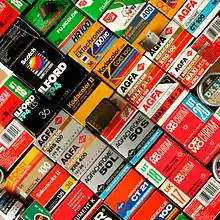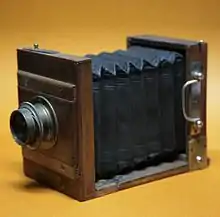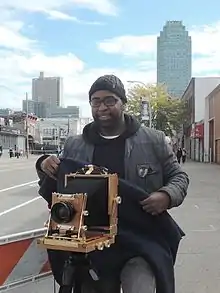Analog photography
Analog photography, also known as film photography, is a catch-all term for photography that uses chemical processes to capture an image, typically on paper, film or a hard plate. These analog processes were the only methods available to photographers for more than a century prior to the invention of digital photography, which uses electronic sensors to record images to digital media.



In a film camera that uses photographic emulsions, light falling upon silver halides is recorded as a latent image, which is then subjected to photographic processing, making it visible and insensitive to light.
Contrary to the belief that digital photography gave a death blow to film, film photography not only survived, but actually expanded across the globe.[1] With the renewed interest in traditional photography, new organizations (like Film Is Not Dead, Lomography) were established and new lines of products helped to perpetuate film photography. In 2017, BH Photo & Video, an e-commerce site for photographic equipment, stated that film sales were increasing by 5% each year in the recent past.[2] Japan Times claimed that though Film Photography is a "dying art", the country could be the starting point of a movement led by young photographers to keep film alive.[3] First Post claimed that a vast majority of photographers are slowly coming back to film.[4]
Decline and revival
As digital photography took over, Kodak, the major photographic film and cameras producer announced in 2004 that it is would stop selling and making traditional film cameras in North America and Europe.[5][6] In 2006, Nikon, the Japanese Camera maker announced that it would stop making most of its film cameras.[7] Incurring losses in analog camera line, Konica-Minolta too announced its discontinuation of cameras and film.[8] In 2008 the first instant film maker Polaroid announced it would stop making instant film.[9]
Interest in all types of film photography have been in the process of a revival. The Lomography movement started in 1992, which, BBC claimed, has saved film from disappearing[10] Lomography started manufacturing updated versions of Toy cameras like Lomo LC-A (as Lomo LC-A+), Diana (as Diana F+), Holga, Smena and Lubitel.
Film photographers started experimenting with old alternative photographic processes such as cyanotypes, double exposures, pinholes, and redscales. Worldwide Pinhole Photography Day is observed on the last Sunday of April, every year.[11] Organizations such as Roll4Roll spread the artistic movement of double exposures.[12]
Film Photography Project, a web-site dedicated to film photography, announced in 2007 the comeback of large-format camera by a new startup called The Intrepid Camera Co.[13]
Material
Film Photography does not just mean photographic film and its processing with photo chemicals. An example is tintype photography. A tintype, also called ferrotype, is a positive photograph produced by applying a collodion-nitrocellulose solution to a thin, black-enameled metal plate immediately before exposure. The tintype, introduced in the mid-19th century, was essentially a variation on the ambrotype, which was a unique image made on glass, instead of metal. Just as the ambrotype was a negative whose silver images appeared grayish white and whose dark backing made the clear areas of shadows appear dark, so the tintype, actually negative in its chemical formation, was made to appear positive by the black plate.[14]
Instant film develops an image automatically, soon after it is ejected from the camera without any processing by the photographer or by a photographic lab. Photographic paper, however must be processed after exposure in a dark room or photographic Labs.
Format
Photographic Film
Silver-based Film supports come in various formats, of which the following are still in use:
- 110 film (mono-perforated roll in plastic cassette)
- 135 film 35mm (bi-perforated roll in metal can)
- 120 film 60mm (non-perforated roll in paper sleeve)
- Large format 4x5" 5x8" 8x10" etc. (gelatin sheets).
- Super-8 (mono-perforated roll in plastic cassette)
- Cinema 16mm / 35mm (bi-perforated roll on metal spool)
Types
Films can be any of the following types:
Processes
Black and White negative film may be processed using a variety of different solutions as well as processing time control, depending on the film type, targeted contrast or grain structure. While many B&W processing developers are no longer made commercially, (Dektol, D-76 and T-Max developers are still made) other solutions may be mixed using original formulas. Color negative film uses C-41 process, while color reversible film uses E-6 process for color slides. Kodachrome used to have its own process with one developer bath per each film color layer.
Meanwhile alternative photographers experiment different processes such as Cross processing which yields unnatural colors and high contrasts. This basically means processing a reversal film using a negative developer bath, or the contrary.
For a more Sustainable Photography, black and white negative film may be processes in plant based chemicals at home.
Film processing does not use analog technology, since information is not translated into electric pulses of varying amplitude.
Popularity
Analog photography is frequently misused as a title for those who are keen to work with, or do work with more traditional types of photography; dedicated online communities have been established in which like-minded individuals together share and explore historic photographic practices.[15] Analog photography has become much more popular with younger generations who have become increasingly interested in the traditional photographic practice; sales in film-based cameras began to soar, and youth were seen to embrace some 19th-century technology[16] Urban Outfitters, a clothing retail chain, has joined the trend and offers more than 60 product combinations relating to cameras, most of which are film-based.
Polaroid was once a power in analog instant photography. Facing the digital revolution, Polaroid stopped production of instant film in 2008. A new company called Impossible Project (now Polaroid through brand acquisition) acquired Polaroid's production machines in order to produce new instant films for vintage Polaroid cameras and to revive Polaroid film technologies.
Black-and-white films still produced as of 2013 include:
- ADOX CHS 100 II
- ADOX CMS 20
- ADOX Silvermax
- ADOX HR-50
- Film Washi "W" 25
- FOMA FOMAPAN 100 Classic[17]
- FOMA FOMAPAN 200 Creative
- FOMA FOMAPAN 400 Action
- FOMA FOMAPAN R 100
- FOMA RETROPAN 320 soft
- FujiFilm Neopan Acros 100
- Ilford Pan F Plus 50
- Ilford HP5 Plus 400
- Ilford FP4 Plus 125
- Ilford Delta 100
- Ilford Delta 400
- Ilford Delta 3200
- Ilford XP2 Super
- Ilford SFX 200
- Kentmere 400
- Kodak T-MAX 100
- Kodak TMY-2 400
- Kodak TRI-X 400
- ORWO UN 54[18]
- ORWO N 74 plus
- Rollei also markets a line of black and white films
Color films (mostly 135 and 120 formats) sold on the market in 2020 are:
- Fujichrome Velvia 50
- Fujichrome Velvia 100
- Fujuchrome Provia 100F
- Kodak Ektachrome 100
- Kodak Ektar 100 Professional
- Kodak Portra 160 Professional
- Kodak Color Plus 200
- Kodacolor Gold 200
- Kodak Vision-3 250 Daylight
- Kodak Ultramax 400
- Kodak Portra 400 Professional
- Kodak Vision-3 500 Tungsten
- Fujicolor Superia 100 R
- Fujifilm Industrial 100
- Fujicolor Superia 200
- Fujifilm Pro 400 H
- Fuji Superia X-tra 400
- Fuji Superia premium 400
- Fuji Superia Venus 800
- Cinestill Daylight 50
- Cinestill Tungsten 800
- Hillvale Sunny 400
- Yashica Color 400
- Yashica Golden 400
Reasons for growing popularity
Young photographers say film has more 'soul' than digital.[19]
Pros and cons
Pros
- The time and expense of film photography instills craft and patience.[20]
- Depending on the film sensitivity you can obtain a wide dynamic range.
- A film-printed (non-editable) image can help as a legal evidence of the subject pictured,
- In optimal processing and storage conditions, a film can have a lifetime duration.
Cons
- Film photography needs more time and skill than digital does.
- Film is delicate and needs careful handling, refrigeration, protection from sun, etc.
- Pictures may suffer film grain and fogging, and also visible dust if not removed.
- Film processing has a cost, if a lab can be found, and needs enlarging or scanning.
See also
- Analog signal
- Digitizing
- Digital photography
- Digital versus film photography
- List of photographic processes
References
| Wikimedia Commons has media related to Analog photography. |
| Wikivoyage has travel information for Travel photography using film. |
- "The photographers who refuse to abandon traditional film cameras". BBC News. 2015-04-18. Retrieved 2020-10-05.
- "The Great Film Renaissance Of 2017". B&H Explora. Retrieved 2020-10-05.
- Takahashi, Ryusei (2019-07-07). "Film photography shows signs of revival among Japan's youth". The Japan Times. Retrieved 2020-10-05.
- "Starting with the niche world of film photography in the era of digital photography- Technology News, Firstpost". Tech2. 2018-01-07. Retrieved 2020-10-05.
- "Kodak embraces digital revolution". 2004-01-13. Retrieved 2020-10-05.
- Davies, Catriona (2004-01-14). "Kodak to stop making 35mm cameras". The Guardian. ISSN 0261-3077. Retrieved 2020-10-05.
- Associated Press (2006-01-13). "Nikon to stop making most film cameras". nbcnews.com. Retrieved 2020-10-05.
- "Konica Minolta to stop making cameras and film amid big losses". the Guardian. 2006-01-20. Retrieved 2020-10-05.
- "Fans bid farewell to Polaroid film - CNN.com". edition.cnn.com. Retrieved 2020-10-05.
- Dowling, Stephen (2012-11-22). "Did the Lomo camera save film photography?". BBC News. Retrieved 2020-10-05.
- "Worldwide Pinhole Photography Day". pinholeday.org. Retrieved 2020-10-05.
- "A roll for a roll". roll4roll. Retrieved 2020-10-05.
- "Intrepid 8x10 Camera - Affordable (NEW!) Large Format Camera". The Film Photography Project. 2017-06-14. Retrieved 2020-10-05.
- "Tintype | photography". Encyclopedia Britannica. Retrieved 2020-10-05.
- "Archived copy". Archived from the original on 2006-10-02. Retrieved 2006-11-04.CS1 maint: archived copy as title (link)
- "Teen hipsters discover joys of analog photography". cnet.com. 16 May 2011. Retrieved 9 April 2018.
- "FOMA - Films". FOMA. Archived from the original on 2013-04-12. Retrieved 2016-10-30.
- "ORWO FilmoTec - Camera Films". ORWO FilmoTec GmbH. Retrieved 2016-10-30.
- Young photographers find film having more 'soul' than digital (The Guardian - 28-Jan-2018)
- Wortham, Jenna (2012-05-30). "Just When You Got Digital Technology, Film Is Back (Published 2012)". The New York Times. ISSN 0362-4331. Retrieved 2020-10-05.
Further reading
- Glenn D. Considine, Van Nostrand's Scientific Encyclopedia, Two-Volume Set, 9th Edition (Hoboken, NJ: Wiley, 2002)
- Peter M.B. Walker, Chambers Technical Dictionary (Edinburgh: Chambers 1999)
- William J. Mitchell, The reconfigured eye: visual truth in the post-photographic era (MIT Press, 1994)